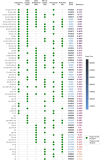Personalized glucose prediction using in situ data only
- PMID: 40551738
- PMCID: PMC12183026
- DOI: 10.3389/fnut.2025.1539118
Personalized glucose prediction using in situ data only
Abstract
The worldwide rise in blood glucose levels is a major health concern, as various metabolic diseases become increasingly common. Diet, a modifiable health behaviour, is a primary target for the preventive management of glucose levels. Recent studies have shown that blood glucose responses after meals (post-prandial glucose responses, PPGR) can vary greatly among individuals, even with identical food consumption, and demonstrated accurate PPGR prediction using various features like microbiome data and blood parameters. Our study addresses whether accurate PPGR prediction can be achieved with a limited and easily obtainable set of data collected in real-world, everyday settings. Here, we show that a machine learning algorithm with such real-world data (RWD) collected from a digital cohort with over 1,000 participants can achieve high accuracy in PPGR prediction. Interestingly, we find that the best PPGR prediction model only required glycemic and temporally resolved diet data. This ability to predict PPGR accurately without the need for biological lab analysis offers a path toward highly scalable personalized nutrition and glucose management strategies.
Keywords: digital cohort; gut microbiome; personalized nutrition; real-world data; real-world evidence.
Copyright © 2025 Singh, Toumi and Salathé.
Conflict of interest statement
The authors declare that the research was conducted in the absence of any commercial or financial relationships that could be construed as a potential conflict of interest.
Figures





Similar articles
-
Signs and symptoms to determine if a patient presenting in primary care or hospital outpatient settings has COVID-19.Cochrane Database Syst Rev. 2022 May 20;5(5):CD013665. doi: 10.1002/14651858.CD013665.pub3. Cochrane Database Syst Rev. 2022. PMID: 35593186 Free PMC article.
-
Effects of a gluten-reduced or gluten-free diet for the primary prevention of cardiovascular disease.Cochrane Database Syst Rev. 2022 Feb 24;2(2):CD013556. doi: 10.1002/14651858.CD013556.pub2. Cochrane Database Syst Rev. 2022. PMID: 35199850 Free PMC article.
-
Atypical antipsychotics for disruptive behaviour disorders in children and youths.Cochrane Database Syst Rev. 2017 Aug 9;8(8):CD008559. doi: 10.1002/14651858.CD008559.pub3. Cochrane Database Syst Rev. 2017. PMID: 28791693 Free PMC article.
-
Magnetic resonance perfusion for differentiating low-grade from high-grade gliomas at first presentation.Cochrane Database Syst Rev. 2018 Jan 22;1(1):CD011551. doi: 10.1002/14651858.CD011551.pub2. Cochrane Database Syst Rev. 2018. PMID: 29357120 Free PMC article.
-
Antidepressants for pain management in adults with chronic pain: a network meta-analysis.Health Technol Assess. 2024 Oct;28(62):1-155. doi: 10.3310/MKRT2948. Health Technol Assess. 2024. PMID: 39367772 Free PMC article.
References
-
- International Diabetes Federation. IDF Diabetes Atlas. 10th ed. Brussels: International Diabetes Federation; (2021).
LinkOut - more resources
Full Text Sources
Miscellaneous

